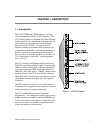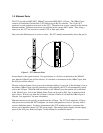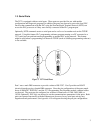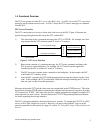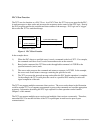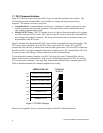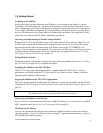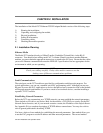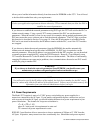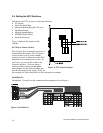CTI 2572 Installation and Operation Guide
7
1.6. TCP/IP Overview
The CTI 2572 module uses TCP/IP (Transmission Control Protocol/Internet Protocol) to transport
messages between the module and other nodes on the network. TCP/IP is a suite of protocols that
provide routing and delivery services for messages between application programs running on
different processors (called hosts in TCP/IP terminology). You may select between connectionless
(packet based) or connection-oriented (stream based) delivery services.
Connectionless Delivery
Connectionless delivery services allow you to send a message to another node without previously
establishing a logical connection to the other node. TCP/IP provides a format known as the
USER
DATAGRAM PROTOCOL (UDP) for sending and receiving connectionless messages. Connectionless
delivery is simple to implement and consumes a small amount of system resources. However,
delivery of UDP messages is not confirmed by the network protocol. It is left to higher level
protocols to acknowledge receipt of a message. Since the Common ASCII Message Protocol
(CAMP) used with the 2572 will acknowledge receipt of a command message, UDP is the preferred
protocol for most applications, such as process monitoring, which obtain data from the PLC.
Connection-Oriented Delivery
With connection-oriented services, you must first establish a logical connection (known as a virtual
circuit) before network nodes can exchange messages. TCP/IP uses the
TRANSMISSION CONTROL
PROTOCOL (TCP) to implement connection-oriented services. TCP provides guaranteed delivery and
message flow control. If a message is not delivered correctly, the TCP protocol will automatically
retry. Since TCP is stream oriented, meaning the application program sees a properly sequenced
stream of data rather than individual packets, it is often used for file transfer applications such as
program downloads. You may choose to use TCP for applications, such as data logging, which
require a specific piece of data be delivered in order.
Socket Interface
TCP/IP uses a standard structure known as a socket, for the application program interface. The de
facto socket standard is the Berkeley Socket, named for the University of California at Berkeley, who
originally distributed TCP/IP. Originally, the Berkeley Sockets were used with only the Unix
operating system. Today, Microsoft Windows includes TCP/IP support using the Winsock standard, a
derivative of the Berkley Socket standard.
Summary
The TCP/IP protocol is used to send and receive messages via the network. It will function over the
local Ethernet network or over Wide Area Networks. TCP/IP supports both connectionless (UDP)
and connection oriented (TCP) services. UDP is usually sufficient for most applications because the
higher-level application protocol (CAMP) incorporates an acknowledgment to commands. TCP/IP
network software for an IBM compatible personal computer is readily available from a wide range of
sources. For a complete discussion of the TCP/IP protocol, see Internetworking with TCP/IP by
Douglas Comer (1991, Prentice Hall) or other commonly available reference material.





